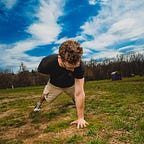An ‘Old School’ Gymnastics Technique for a Freakishly Strong Core
One of the most unsung ways of building strength is isometric strength and static strength.
Isometric strength is where you push or pull against something that won’t budge. Static strength is where you seek to hold firm in the face of some sort of resistance.
A good example of the former would be trying to push a boulder that is stuck firmly in the ground. And an example of the latter would be something like…well, the movement I’ll tell you all about in this article.
Now, some people class these two moves in the same category, but either way there are some subtle nuances between the two. Nevertheless, while both are awesome, I want to talk a little bit about the benefits of static strength and how to obtain it.
Far and away, the best static strength moves around are those found in the cadre of bodyweight exercises — exercises like L-sits, handstands, levers, and what have you.
Most people nowadays shy away from them, mainly for 2 reasons:
1) They don’t know what they’re good for, and
2) They’re tough as nails
As far as the first thing goes, movements like pullups, pushups, squats, and what have you all seem to be relatively obvious as to their utility. Holding your legs out in front of you as you remain motionless in an L-sit progression? Holding your body firm as you lean back with an arched back on a pullup bar? Not so obvious, it would seem.
If you’ve never done them before, I highly recommend you start with none other than the L-sit.
So, here’s the short list of benefits of straight-arm static strength exercises in general, and L-sits in particular:
“Straight-arm strength IS upper body strength”
These are the immortal words of movement maestro Ido Portal on the benefits of straight-arm static work. As he points out, when the muscles surrounding the scapulae (shoulder blades) are strong and stable, the carryover into other strength and athletic activities is second to none (hence the reason why you see so many former gymnasts competing at high levels in a variety of other sports)
It can improve your pullups and presses
Gymnastics coach Christopher Sommer has a variety of tales about the benefits of gymnastics strength training for non-gymnasts.
One of my favorite comes from “Dave”, a recreational kayaker, who talks about how he took his chinup numbers from 7 to 14 and his dips from 8 to 15 — without practicing chin-ups or dips — simply by doing 2 very basic progressions of the front lever and the planche.
He also noted that his upper body no longer got tired when he kayaked with his buddies. Who couldn’t use a stronger, more resilient upper body?
While you might be tempted to jump right into front lever and planche progressions, you probably won’t get very far if you can’t first rock the mighty L-sit.
Now, as for their being tough as nails, the simple solution to that is to find a progression that you can hold for, say, 20 seconds, and do sets of 10 seconds or less with 60–90 seconds rest between sets. A good example would be:
Set 1: 5-10 seconds, rest 60 seconds
Set 2: 5-10 seconds, rest 60 seconds
Etc.
(Side note: rest periods of up to 3 minutes might be even better — just be sure to adjust your schedule accordingly)
Not only is this non-exhaustive (meaning it can ostensibly be done daily), but highly effective for preparing your body not only to improve at those movements, but to create greater stability and strength in and around your scapulae, thus giving you a stable platform from which to launch heavier presses and pulls (and potentially with fewer nagging shoulder issues, which is a big plus).
One of the most basic straight-arm strength movements is the L-sit, and even if the full one eludes you, you can most definitely find a progression that get you stronger. Here’s a short guide to help you get started:
On that note, if you like training that:
- Gives you more strength than it takes from you
- Improves your stamina and resilience simultaneously
- Powers-up every nook, cranny, crevice, and corner of your Soft Machine
Then you just might like my 9-Minute Kettlebell and Bodyweight Challenge.
As the name indicates, it’s just 9 minutes long, and it’s designed to be done WITH your current workouts — NOT instead of them.
Even cooler:
Many find that it actually amplifies their strength in their favorite kettlebell and bodyweight moves, like presses, squats, pullups, and more.
And best of all, it’s free.
How free?
I’m talkin’ freer than the 4th of July, my friend.
Get thee thine own copy here => http://www.9MinuteChallenge.com
Have fun and happy training!
Aleks Salkin
